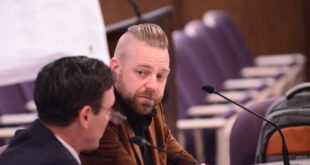
After being told twice in the past two years to return to the drawing board, representatives of a Booker Street church on October 16 seemed to present a plan for a new building with which Planning Board members can live.
Representatives of Macedonia Church of God In Christ International were told in 2022 and most recently last July that their plan to raze their current building at Booker and Fuller streets was too ambitious, and tit needed to be reworked. The application has been kicking around for the last seven years.
Judging by the fact that no such suggestion was made at the October 16 hearing. it seems the current offering is more to the Planning Board’s liking.
The changes are minimal: the number of on-site parking spots was reduced from 38 to 36, and the length of the building was reduced by five feet.
The parking need was reduced because the number of seats inside the church was reduced from 300 to 183. This was achieved by eliminating 60 permanent seats on the building’s balcony, according to a memo from Larry C. Johnson, the project’s architect.
Johnson was not at the October 16 hearing; church attorney Peter Lanfrit said he did not know where Johnson was.
Reducing the building’s length and the number of parking spots needed allowed for increased space between the building and the property line – known as the buffer – although it did not obviate teh need for a variance from the township’s Zoning Ordinance.
In total, the project needs nine design waivers or ordinance variances.
Ronald Sadowski, the project’s engineer, testified that there would also be six electric vehicle charging stations, a change that sat well with Board member Ted Chase.
“As a representative of the Environmental Commission, I’m very happy to hear that,” he said.
Board chairman MIchael Orsini told the Board that variances in the project were inevitable, and the choice was going to have be made whether the benefits of the church outweigh the negatives of the variances.
“The first time you were through, we asked you to come back with some changes if you can,” he said. “They don’t eliminate variances, they make them less severe. So, I just want the board to be aware as we go through the testimony, that the lot is small. I mean, there’s just no way around that. And so if you want to build a church on it, there’s probably going to be some variances.”
“And then there are some design waivers,” he said. “So just the board can keep in mind, the way I look at it is, if you’re going to build … a church, which is what the use is there now, it’s somewhat of a balance between the art of the possible. You’re going to have variances. I don’t think there’s a way to do it without it. The question is, does the board believe that those benefits outweigh the detriments?”
“I think, in terms of what you’ve done, you could argue, could you reduce the building by more than five feet?” Orsini continued. “Eventually you’re putting forth an application, you’re putting a stake in the ground saying this is what we would like to propose and then it all depends on whether we approve it or not.”
“Do I think you’ve improved it? Marginally, yes,” Orsini said. “But we’ll see in the rest of the testimony what actually we will have.”
Orsini noted that the plans state the balcony is reserved for future seating, but Lanfrit told him that should not have been included in the plans.
“No, that was not to have been on the plan, Mr. Johnson will testify to that,” Lanfrit said. “But the answer is there will be no proposed seating at the present or in the future in the balcony.”
“No, that’s fine,” Orsini said. “I just want to make sure that what the board is looking at is what the applicant is proposing and we’re not doing a site plan for the future so thank you for that.”
Jay Troutman, the project’s traffic engineer, said he redid his study to see what the parking situation would be.
He said that there would be a total of 162 parking spaces available to the church, on- and off-site, including some provided through an agreement with RPM, the company redeveloping the Renaissance neighborhood.
“I went out there on a Sunday morning, starting at around 10:15 a.m., keeping in mind that the church service doesn’t start until at least 11, actually on that day it started at 11.30 and it had, it peaked at about 12 o’clock noon,” he said. “So I started at 10:15 a.m. and I set up a survey area to survey all of the parking occupancy in the church parking lot to see what’s actually available on Sunday morning in that lot.”
“I broke out every street surrounding the site.” he said. “I did Fuller along the church frontage. I did Fuller across from the church frontage. I did Booker along the church frontage. I did Booker across the church, from the church frontage. And then I did the block of Booker heading out towards Somerset Street as well.”
“And basically what we found was that there will be 36 physical parking spaces in the proposed church parking lot,” Troutman said. “I did find in the RPM lot that there were a minimum of 13 empty parking spaces. So the empty spaces in the RPM lot ranged anywhere from 13 to 18, depending on time.”
“I also found that there were 43 available parking spaces on the adjacent streets, and then we also had the agreement with PNC (Bank), if there’s an event of such a size where we could shuttle people from the PNC lot, that would gain another 70 parking spaces, so I concluded in my report that there would be 162 available parking spaces for the church,” he said.
During a discussion of how the parking space calculation is made – it’s based either on the number of seats or on a square-foot basis – Lanfrit suggested that the Board could require in its approval that the church’s basement and balcony not be used for seating. Orsini rejected that, saying things like that are practically impossible to enforce.
The next hearing on the application will be at the Board’s November 6 meeting.
 The Franklin Reporter & Advocate Eight Villages, One Community
The Franklin Reporter & Advocate Eight Villages, One Community

